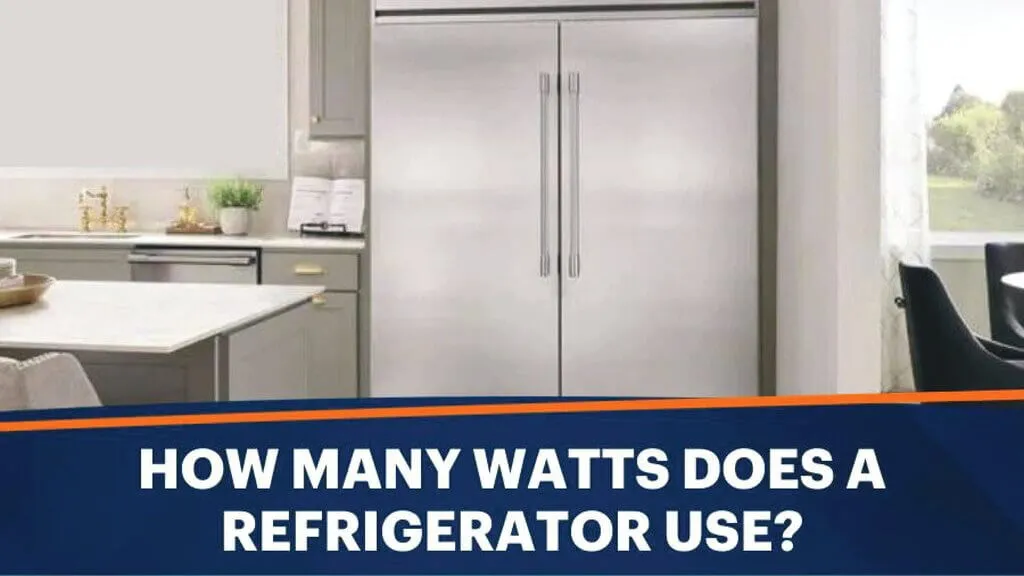The refrigerator is one of those appliances that run 24/7. Knowing the watt consumption can help you understand the monthly expense of refrigerators and a way of cutting the cost. So, how many watts does a refrigerator use?
On average a refrigerator uses around 130-400 watts per hour and 1-3 Kw per day since the compressor runs 1/3rd of the time. The cost will be around $7-$20 per month. You can simply calculate it by multiplying the AMP listed on the nameplate with voltage (generally 120v) or hour with wattage.
However, the math is more complex since the ultimate wattage of your refrigerator depends on many factors including: type of refrigerator, size, location, season, usage, temperature, age, and conditions. You can also control the cost by following some effective measures.
This article will shed light on everything you should know about your refrigerator wattage and energy consumption.
Table Of Contents

How Many Watts Does a Refrigerator Use Per Day?
You can easily find out how many watts your refrigerator uses per day with the help of its nameplate (sometimes called data plates). And of course, for an even accurate measurement, you can also use a power meter.
Calculate How Many Watts a Fridge Uses by Using a Nameplate
Check the nameplate of your fridge to find out the running watts, voltage, and Amp. Some refrigerators have voltage measurements, whereas some come with watt measurements.
For voltage measurement, multiply the voltage by the Amp and then convert it into kWh, keeping the compressor run time in mind. For example,
Let’s say the voltage is 120v, and the Amp is 1.25.
So the watts used by the refrigerator is 120×1.25= 150 watts per hour.
150 watts per hour x 24 hours per day = 3600 watts per day. But the compressor usually runs 1/3rd of the total time. That means the compressor usually runs 8 hours a day.
So 150 watts per hour x 8 hours per day = 1200 watts per day. Converting to kWh = 1200/1000=1.2 kWh, per month = 1.2×30= 36 kWh. If the charge is $0.20 per kWh, the cost will be $7.2 per month, and the estimated yearly electricity cost will be $88.4.
For watts measurement, multiply the wattage by the hours you use per day. Generally, we use the fridge 24/7. So multiply the wattage by 8 since 1/3rd is compressor run time. For example,
Let’s say the nameplate has 130w instead of the voltage mentioned.
So 130Wx8= 1040w = 1.04 kWh per day. Converting it to month – 1.04 kWh x 30 = 31.2 kWh per month. So your electricity cost will be 31.2 kWh x $0.20 = $6.24 per month and $75 per year.
Calculate How Many Watts a Fridge Uses by Using a Power Meter
A power meter gives you an accurate measurement of how many watts or energy your refrigerator uses. Attach the power meter to the compressor and measure the power consumption for a compressor per day. You will also find out how long a compressor runs per day accurately.
For example, let’s say your compressor runs for 7 hours daily and consumes about 200 watts per hour.
So the power usage shall be: 7 x 200 = 1400 watts per day = 1.4 kWh per day = 1.4 x 30= 42 kWh per day = 42 x $.20 = $8.4 per month and $8.4 x 12 = $100.8 per year.
How Many Watts Does a Small Refrigerator Use?
Unfortunately, there’s no straight-cut answer to how many amps does a mini fridge use or how many watts it requires. A standard American mini fridge may need anywhere between 60-120 watts per day. Again, like we said before, the exact wattage use depends on several influencing factors.
One of the friends discovered that his mini fridge’s compressor uses 90 – 100 watts daily and runs around 6 hours and 10 minutes daily.
Hence, his refrigerator’s daily power consumption is 61 kWh. Therefore, the amount of power consumed each month will be 18.3 kWh. Consequently, the electricity costs will be $3.66 per month and $43.92 annually.
Factors Affecting The Power Consumption of a Refrigerator
Several factors influence the power consumption of your refrigerator. Let’s discuss them in detail:
Refrigerator Size
Different-sized refrigerators use different watts – a mini fridge requires less energy than larger ones. Here’s a brief overview for you. Remember, this is a general list of the average running watts that may vary with other factors.
| Size | Average Power Consumption Per Year |
| 200 L | 720 kWh |
| 300 L | 900 kWh |
| 400 L | 1080 kWh |
| 500 L | 1440 kWh |
| 600 L | 1800 kWh |
Energy Star Rating
An energy star rating indicates how much energy efficient the fridge is. A higher energy star rank means the refrigerator uses less energy to operate smoothly which is not.
Frequency of Opening the Fridge Door
A fridge door keeps the cool air inside. When you open it, warm air comes in, and cool air goes out. The more you open it, the more power it will require to cool the fridge. Therefore, frequently opening may eventually damage a refrigerator.

Age and Condition of the Fridge
Is your fridge too old? If so, chances are high that it will have more electricity usage. Generally, older fridges use older technology, which causes higher electricity consumption. Modern refrigerators use cutting-edge advanced technology, keeping energy conservation in mind.
Temperature Setting
It is common sense -the lower the temperature setting, the higher the refrigerator’s wattage consumption. The refrigerator requires more watts to make the air cooler.
Refrigerator’s Location
Your refrigerator needs enough ventilation to draw air. If the refrigerator is confined, it will consume more wattage to draw air from outside and let the hot air out from inside.
Usage Pattern
The pattern of refrigerator use plays a vital role in determining your electric bill. Putting hot foods will cost more wattage for the compressor to make the fridge cool. On the contrary, storing pre-chilled or normal-temp food will ease the efforts of the fridge compressor.
Room Temperature
Room temperature is also responsible for a refrigerator’s power consumption. You need more power to cool the fridge when the room temperature is higher. Besides, the compressor will draw warmer air inside the fridge, making the fridge consume higher power to cool the air.
Refrigerator Type
The type also affects fridge power. Some refrigerators come with advanced technology that reduces the overall power consumption of the fridge, whereas some come with technology to consume more power. For example, R-22 model fridges are less energy-efficient than R-410A.
Additional Features That Can Increase the Wattage Use
Additional accessories require more energy. For example, an ice maker can increase wattage usage by 81 kWh, eventually increasing electricity costs. The same goes for water dispensers, touchscreen, wi-fi, and others.
The calculation is simple. The fridge will require more energy or electricity to run those additional accessories. So the energy costs will be higher for fridges with those accessories than those without.
7 Tips to Reduce The Energy Consumption of a Refrigerator
No matter how big-sized your refrigerator is with all the advanced tech features, if you’re on a shoestring and concerned about insane electricity bills, there are some smart hacks through which you can easily reduce the average wattage consumption of your fridge and similarly reduce the costs of running your refrigerator. Here are some steps you can take:
The optimum temperature is 37 degrees Fahrenheit for your fridge to keep regular food items. Make sure you keep the temperature right for better energy savings. Lowering that will consume more energy that will increase the electric bills.
Try to higher the temperature setting when you have no perishable food inside. It will reduce the power consumption to a great level.
Yes, you can reduce energy usage by keeping the fridge full. When you open an empty fridge, all the cold air comes out, reducing the cooling capabilities. A full-stocked fridge can absorb all the cold air. As a result, when you open the door, a little cold air comes out, and the fridge requires less power to make the air cold again.
However, don’t put food too close to the vents when stuffing the food. It will block the air vents, causing your fridge to work more, hence resulting in more wattage consumption.
Proper maintenance and cleaning play a vital role in reducing refrigerator power consumption. Clean the condenser coils, compressor, air vents, and the inside of a fridge regularly. Check the door gasket to make sure it’s sealed properly. Regular maintenance will reduce the burden on the fridge compressor and prevent it from working extra hard over time to keep those foods cold and fresh.
Another great way to reduce energy usage is perfect placing. Place the refrigerator so the compressor has enough space to draw the air. Besides, try to place it in a cool place with better ventilation. Avoid direct sunlight.
Keep at least 6-12 inches between the fridge and the wall. It is better to have more space for better ventilation.
If you want to save maximum energy, never ever open the door unnecessarily. When you open the door, the cool air comes out, and the fridge needs to make the air cold again. It ultimately increases energy use.
You can try renewable energy, such as solar power, to reduce the overall electric bill of your house.
Using energy-efficient refrigerators can help. An old model fridge consumes more energy than the latest model with cutting-edge technology. Try to buy one with a higher energy star rating.
Of course, you can opt for a mini fridge since it consumes less energy. However, you might need more than a mini fridge for your household needs. So be careful before buying a mini fridge.
Wrapping Up
Knowing the watts a fridge uses can help you reduce the overall cost. Besides, knowing the watts can also be helpful if you plan to use a generator for a power outage or emergency.
In today’s world, energy conservation is more important than ever. Moreover, when it comes to a refrigerator that runs 24/7, saving energy is mandatory.
Try to make some atomic changes to bring revolutionary conservation. Adjust the temperature setting, clean the fridge regularly, or upgrade to an energy-efficient model to reduce energy usage. It will help you save energy and build a better future.
